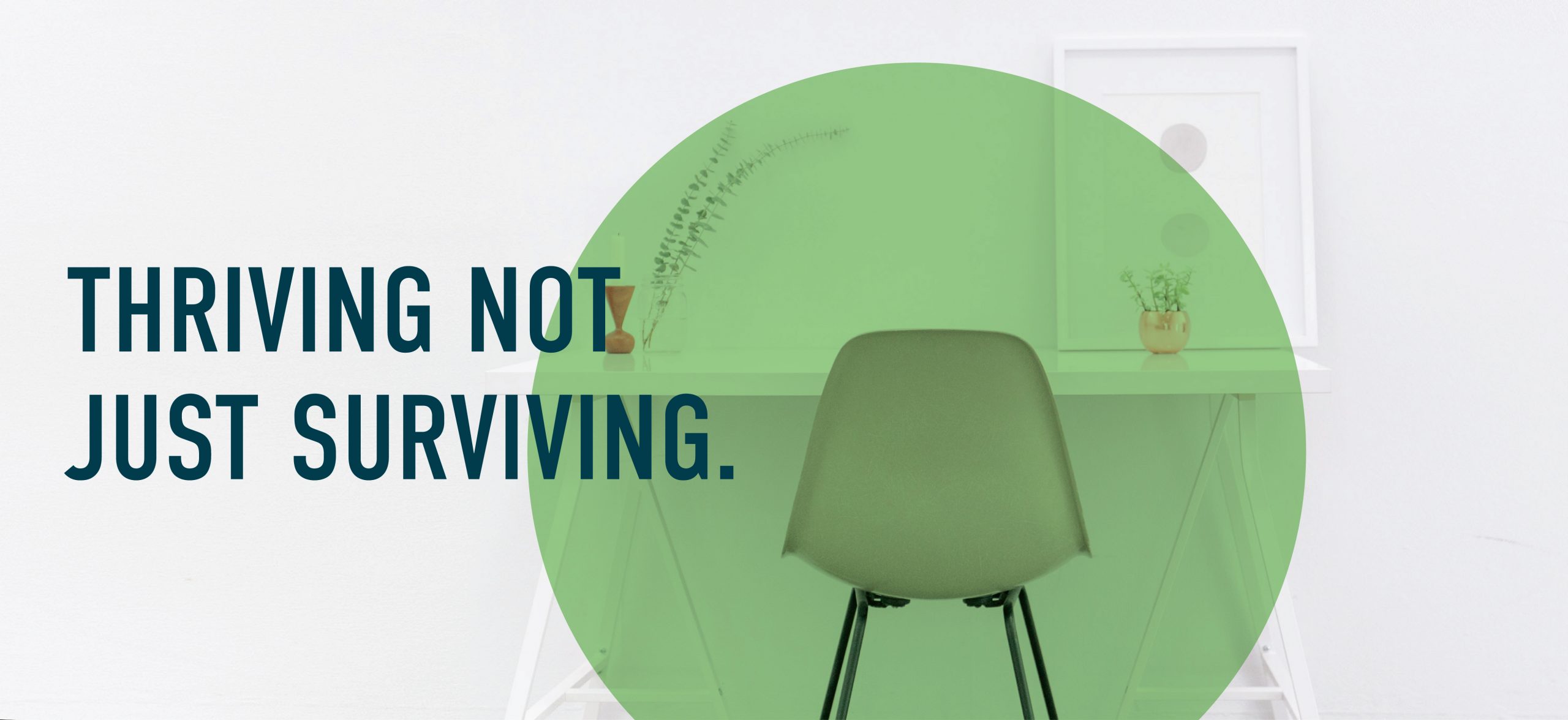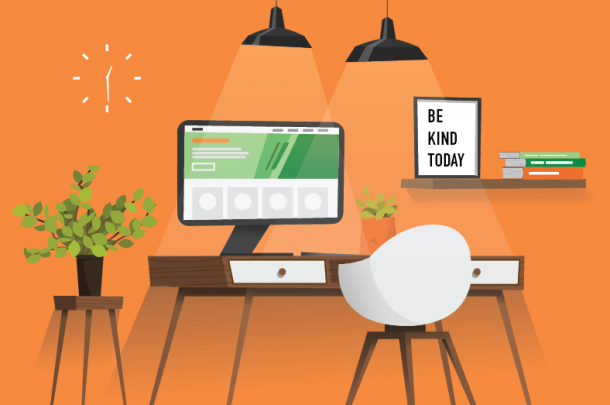
As you, dear reader, are well aware, the U.S. is now exactly one year into the COVID-19 pandemic. For many in the Midwest, March 13, 2020 was the last day in our offices. March 16, 2020 marks the first full day of working from home for what many of us thought would be two to three weeks. While the tide has seemingly turned with vaccine rollouts, warmer weather, and steadily dropping case numbers, the future and timing of reopening is still quite uncertain. The risk continues, and pandemic fatigue is real. So, how do we continue to live and work with the unknown? By now, you’ve most likely heard of several tips to keep motivated during the pandemic, but with this week marking the one-year anniversary we thought it a good time for a refresher on ways to continue looking after yourself.
As the weather warms up and the sun stays out later, get outside! Research has shown us long before this pandemic that being outside is beneficial to human health. Kathleen Wolf, PH.D. of the University of Washington’s School of Environmental and Forest Sciences, says, “Research doesn’t support the claim that you can only get health benefits from being in the wilderness. While wilderness experiences are beneficial, it’s just as important to have nature incorporated into your daily life.”
Sick of your daily walk? Try something new! Can you sit outside while you work or take a call on the go? If not, take your lunch outside or change up your route. Even opening the windows in the house or on a drive may give you some much-needed fresh air.
According to the World Health Organization, now is a critical time to get physical activity. “During the COVID-19 pandemic, when so many of us are very restricted in our movements, it is even more important for people of all ages and abilities to be as active as possible. Even a short break from sitting by doing 3-5 minutes of physical movement, such as walking or stretching, will help ease muscle strain, relieve mental tensions, and improve blood circulation and muscle activity.”
So, assess how much physical activity you’re currently getting and challenge yourself to increase it or change it up. Try going for a bike ride, following along with a workout video, taking more movement breaks throughout the day, or dancing.
Manage those work boundaries! It seems we are constantly fine-tuning this, but it’s more important than ever when work and home share the same physical space. So, shut that laptop at the end of the day and, heck, maybe even on your lunch break, too! Along those lines, you’ve most likely heard the advice to create a separate, defined space for work in your house in whatever way works for you. Now’s the time to reevaluate that space and adjust as is fitting.
Routines are good, but rituals are better. Routines are those things you do because you should, but you’re not particularly excited about, like brushing your teeth, making your bed, or changing your clothes. Routines make life easier for your brain because it knows what to expect and when. Rituals can be similar in that you do them every day, but they are things you look forward to, like a special lunch, picking up your kids, or journaling. You can even turn a routine, like cleaning or exercising, into a ritual if you do it mindfully or with excitement.
Especially if you’ve been working at home, take the advice of Deloitte’s Chief Well-Being Officer, Jen Fischer, and give yourself something to look forward to every day. It can be as simple as putting on clothes that excite you, doing a Pilates video, making yourself a latte or tea, or anything else that can be done in 15-30 minutes. It doesn’t need to take a lot of energy or time; simplicity is key.
Let’s talk about “Zoom fatigue!” The University of California, San Francisco Weill Institute for Neurosciences, Department of Psychiatry and Behavioral Sciences put out a publication validating “Zoom fatigue” as a real phenomenon. We are used to receiving strong signals from people in person – voice, body language, etc. – and over video we receive only weak signals, meaning our brains must work harder to interpret them.
Common advice since the beginning of the pandemic has been to remain in contact with loved ones, especially over Zoom or FaceTime, but if it exhausts you, lean into that. You can still connect with others via a good old-fashioned phone call. If it is in your control, consider whether you really need to see the other person’s face. If you aren’t calling the shots, maybe you don’t need to be on camera. If you can join with audio only, try it out. If you must, though, do your best to schedule 10-minute breaks in between video calls.
Also, if your devices have the option, turn on the blue light filter. On those that don’t, check the settings and switch to a dimmer screen if you haven’t already. It’ll be easier on your eyes, especially if you’re taking work or personal calls closer to bedtime.
Speaking of sleep, let’s make it a priority. An article by the National Heart, Lung, and Blood Institute states researchers “have concluded that improving our sleep schedule and quality is an important part of coping with these stressful times and defending against COVID-19.” We also know that “getting enough good quality sleep at the right time of day improves energy levels, emotional and mental health, and builds a stronger immune system.”
Getting good sleep keeps our immune system strong and our stress levels low. Who wouldn’t want that? The U.S. Department of Health and Human Services offers a nice primer on assessing and improving your sleep and a sample sleep diary they suggest keeping for one week if you want to improve your slumber (check the links below).
Learn something new or engage in a regular creative activity. Research shows, as cited in a Harvard Business Review (HBR) article, that learning something new, whether related to your job or not, boosts work engagement and quality. In yet another HBR article, author John Coleman states, “reading, even for short periods of time, can dramatically reduce your stress levels.” Take a community college class, learn an instrument, check out local parks and recreation programs, paint, or pick up a new language.
Use this remaining time at home to take care of things you won’t want to when your social calendar picks up again – getting rid of old paperwork, decorating that space you’ve been eyeing for years, and clearing out your inbox.
Lastly, if you’re struggling, know that many of us also are, have, or will. Tell someone, reach out, cry, pray, or whatever works best for you – we’re all in this together, and will get through it together.
References:
- https://www.cdc.gov/coronavirus/2019-ncov/vaccines/fully-vaccinated-guidance.html
- https://psychiatry.ucsf.edu/copingresources/covid19#b
- https://rightasrain.uwmedicine.org/life/leisure/why-you-should-still-go-outside-when-weather-sucks
- https://thriveglobal.com/stories/pandemic-fatigue-staying-focused-self-care-work-from-home/
- https://www.nhlbi.nih.gov/news/2020/covid-and-sleep-better-slumber-during-pandemic-may-help-protect-your-health
- https://health.gov/myhealthfinder/topics/everyday-healthy-living/mental-health-and-relationships/get-enough-sleep#panel-1
- How Much Sleep Do I Need? Recommended Sleep Times 2021 (sleepadvisor.org)
- https://magazine.medlineplus.gov/pdf/SleepDiary.pdf
- https://hbr.org/2017/02/lifelong-learning-is-good-for-your-health-your-wallet-and-your-social-life
- https://hbr.org/2019/02/why-you-should-work-less-and-spend-more-time-on-hobbies?utm_medium=social&utm_campaign=hbr&utm_source=linkedin&tpcc=orgsocial_edit
- https://www.who.int/westernpacific/news/q-a-detail/coronavirus-disease-covid-19-staying-active







 Top Workplaces USA
Top Workplaces USA 







